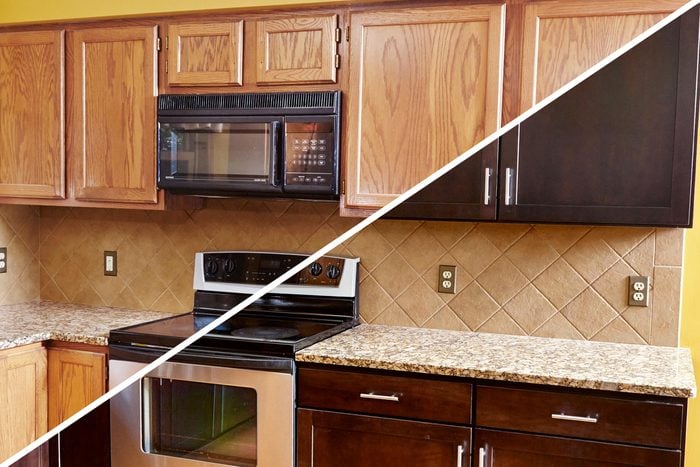What To Know About Kitchen Cabinet Refacing
Updated: Dec. 21, 2023

If you're tired of looking at your old cabinets but don't want to replace them, cabinet refacing may be the answer.
Did you know the average cost of kitchen cabinets for a remodel is around $11,000? While kitchen remodels often come with a healthy return on investment, that’s still one big bill. Imagine if some of that money could go toward appliances, flooring or other custom touches.
That could be a reality if you choose to reface your cabinets instead of replacing them! Here’s what you need to know about kitchen cabinet refacing.
On This Page
What Is Kitchen Cabinet Refacing?
Cabinet refacing takes old cabinets and breathes new life into them. It’s essentially a makeover, saving you money while providing high-quality results. You leave the old cabinet boxes in place, cover their fronts and sides with new material, then replace the doors and drawer fronts.
Refacing usually involves attaching laminates or a hardwood veneer to the front of the cabinet boxes (aka face frames) and the sides with long-lasting contact cement. Once it’s trimmed to the exact shape and size of the face frame and cabinet ends, they look like they’re made from totally new cabinet material.
Because most cabinet doors have inset panels, they aren’t as easy to cover with laminate or veneer. Instead, these are typically replaced with hardwood doors and drawers ordered from the same manufacturer that provided the hardwood veneer. The same applies to the moldings around the cabinets.
In many cases, cabinet refacing is a DIYable project. With careful preparation and the right products and tools, many DIYers can give their kitchen a fresh look for far less than buying new cabinets.
Pros and Cons of Cabinet Refacing
Like most home improvement projects, cabinet refacing has its pros and cons. It’s important to understand the benefits and drawbacks are before refacing your kitchen cabinets.
Pros
-
Less expensive than replacing kitchen’s cabinets.
-
Refacing generally takes less time than removing the old cabinets and installing new ones.
-
The process is less invasive than replacing cabinets. In some cases, you can leave dishes and cookware on the shelves when refacing the cabinet boxes.
-
Other than throwing out a few cabinet doors and some outdated hardware, there’s not much demolition. Thoroughly cleaning the face frames is typically all the preparation it takes. This makes it a greener, eco-friendlier option than trashing old cabinets.
Cons
-
It doesn’t solve actual problems. Broken or damaged cabinets are not good candidates for refacing. If the cabinet has water damage, or the face frame is broken or separating from the sides, it’s better to replace than reface.
-
It takes several days of painstakingly accurate work. For some DIYers, that might be too much commitment. Another option is painting the cabinets, but that’s also a big project.
-
It won’t improve the interior and underside of the cabinet boxes. You may have to add painting those to your to-do list.
-
If the kitchen layout isn’t functional or desirable, refacing may be a waste of time and money. A new layout typically requires new cabinets.
Kitchen Cabinet Refacing Costs
In general, the cost to reface the cabinets ranges between $4,000 and $8,000. For a small kitchen, the costs could be as low as $1,000; an average-sized kitchen runs about $6,500. The price depends on the quality and species of the veneer, the cabinet doors and drawer fronts, and the new hardware.
Kitchen Cabinet Refacing Tools and Materials
Before starting a cabinet refacing project, gather these materials:
- Sandpaper;
- Denatured alcohol;
- Veneer (available in sheets or strips);
- Matching doors and drawer fronts;
- Thin plywood or veneer blanks for cabinet ends;
- Laminate cutter or utility knife and straight edge;
- Veneer roller;
- Water-based contact cement;
- Door hinges;
- Door pulls and knobs.
Is Kitchen Cabinet Refacing Worth It?
It depends. If you like the layout of your kitchen but want to upgrade and update the cabinets, refacing can definitely be worth it. However, if there are broken cabinets or the kitchen’s layout just doesn’t work, you might be better off replacing the cabinets rather than trying to dress them up.
In either case, consider the cost of refacing, the savings and the amount of work it takes. In some cases, it makes sense to replace one broken cabinet refacing the rest. In other cases, given the work involved, hiring out the job to a pro may be the way to go.
